AM: FLIGHT TO GALAPAGOS
Your journey begins with a flight to this remarkable archipelago. Upon arrival, VIP representatives will assist you with all entry formalities, including the migration card ($20) and National Park fee ($200 for adults as of September 2024, and $100 for children under 12). After a brief biosecurity clearance, your personal naturalist guide will greet you and escort you to private transport.
While the crew handles your luggage, you’ll be transferred to the Seaman Journey via a comfortable tender boat, known locally as a "panga." This short scenic ride delivers you directly to your boutique yacht, where the crew awaits with refreshments to welcome you aboard. Every detail has been arranged to ensure your arrival is seamless and comfortable, so you can begin your Galapagos adventure in style.
PM: BARTOLOME ISLAND
You will visit Bartolome Island, located across Sullivan Bay. From its 114-meter (approximately 375 feet) summit, you’ll enjoy one of the most stunning views in the Galapagos, featuring volcanic cones, lunar-like craters, lava fields, and the famous tuff-formed pinnacle eroded by the sea.
You’ll explore two breathtaking beaches where you can spot marine turtles swimming alongside sea lions. At the base of the pinnacle, you’ll find a tiny colony of Galapagos penguins.

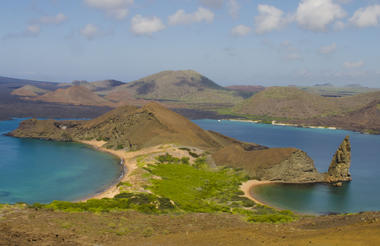

AM: MOSQUERA ISLET
You will visit Mosquera Islet, located between North Seymour and Baltra. This is one of the smallest islands in the Galápagos, formed by geological uplift and volcanic origin. It has no visible crater, and its terrain is very flat.
One of the most striking things you’ll notice at Mosquera is the contrast of colors — a beautiful white sandy beach, transparent turquoise waters, lush green vegetation, and jet-black lava rocks. It’s a perfect spot for landscape photography, especially during the golden light of early morning or sunset.
PM: NORTH SEYMOUR
Next, you’ll explore North Seymour, a remarkable elevated island with an easy, level walking path across a pristine landscape. Here, nature puts on an intimate show of Galápagos wildlife just for you.
You’ll watch magnificent frigatebirds nesting among the low shrubs, with males proudly displaying their brilliant red throat pouches. Nearby, charming blue-footed boobies will perform their delightful courtship dances just a few feet from the trail. Along the shoreline, playful sea lions will ride the waves, while elegant swallow-tailed gulls perch gracefully on the cliffs.
Our expert guides will lead you along well-maintained paths, making sure you have comfortable viewing and great photo opportunities of these fascinating creatures in their natural habitat. Your visit can be as active or as relaxed as you like, with plenty of spots to rest and soak it all in.



Breakfast
Lunch
Dinner
AM: GENOVESA, ISLAND EL BARRANCO – THE CLIFF
You’ll begin your morning exploration along the southern edge of Darwin Bay on El Barranco. This 1.5 km trail crosses volcanic terrain and usually takes about two hours at a leisurely pace. As you walk, you’ll discover one of Genovesa’s most remarkable bird sanctuaries, where red-footed and masked boobies nest closely together.
Keep an eye out in the cliff’s natural cavities for fascinating storm petrels and their main predator, the short-eared owl. You’ll also enjoy dramatic views of the coastline both from the trail and during a comfortable panga ride, where you might spot fur sea lions resting on the rocks.
Note: This is one of only five places in the entire archipelago where red-footed boobies nest, making it a truly special destination for wildlife lovers like you.
PM: DARWIN BAY
In the afternoon, you’ll visit Darwin Bay, which was formed when the island’s crater collapsed below sea level. You’ll make a wet landing on a beautiful white coral sandy beach. This island is a favorite among birdwatchers, giving you the chance to see a variety of species including red-footed boobies, masked boobies, wandering tattlers, lava gulls, whimbrels, yellow-crowned and black-crowned lava herons, and yellow warblers.
As you continue along the trail, you’ll spot red-footed boobies nesting in the mangrove trees below. You’ll also have opportunities to see sharp-beaked finches, large cactus and ground finches, Galapagos doves, and swallow-tailed gulls. Along the way, tidal pools provide a habitat for coastal and sea birds like night herons, while playful sea lions might entertain you nearby.
This spot is also great for snorkeling, where you might encounter small reef-tip sharks, sea turtles, and hundreds of colorful fish. If you prefer, sea kayaking is also available to explore the bay from the water.



Breakfast
Lunch
Dinner
AM: PLAZAS ISLANDS
You will visit South Plazas, located east of Santa Cruz Island, part of the two islands known as Islas Plazas. Despite its small size, some of the most interesting and unique Galapagos species call this island home.
You’ll notice that the Plazas land iguanas here are smaller than their relatives on other islands. Throughout the island, you may spot several hybrid iguanas — a rare cross between a male marine iguana and a female land iguana. These hybrids are easily recognizable by their black/gray color, with a land iguana’s crest but the face and tail of a marine iguana.
The large population of iguanas is supported by the abundance of tunas, their favorite food. Along the rugged cliffs, you’ll see swallow-tailed gulls nesting alongside other seabirds such as Audubon shearwaters, red-billed tropicbirds, frigatebirds, and brown pelicans.
PM: SANTA FE
In the afternoon, you’ll disembark into beautiful, clear waters and find yourself close to one of many sea lion colonies. As you walk the trail, you’ll see salt bushes and giant prickly pear cacti — a perfect example of island gigantism.
There are great opportunities for snorkeling here, where you can swim with playful sea lions and vibrant tropical fish, creating unforgettable underwater memories.

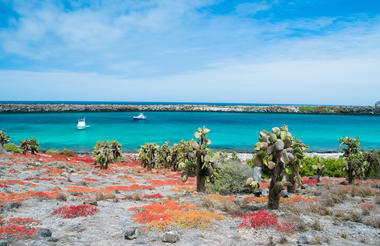

Breakfast
Lunch
Dinner
AM: DAVID RODRIGUEZ LAND TORTOISE BREEDING CENTRE
Your morning in the Galapagos begins with a visit to the prestigious David Rodriguez Tortoise Center, a conservation gem dedicated to protecting San Cristóbal’s native giant tortoises. Named after a devoted park ranger who served these islands for 39 years, this advanced breeding facility plays a vital role in preserving these magnificent creatures.
You’ll take a scenic 40-minute drive through the island’s highlands near Cerro Colorado to reach the center. Here, you’ll see the remarkable Chelonoides chathamensis tortoises living in a carefully designed natural habitat. Established in 2002 and continuously refined, this facility represents the pinnacle of conservation excellence in the Galapagos.
PM: GIANNI ARISMENDY ENVIRONMENTAL INTERPRETATION CENTRE
In the afternoon, you’ll visit the Gianni Arismendy Environmental Interpretation Centre, surrounded by lush gardens and stunning ocean views. Here, you will learn about the geological and human history of the islands, as well as important conservation efforts and natural history.
As the oldest natural history museum in the Galapagos, this center is dedicated to preserving the archipelago’s unique ecosystem, giving you a deeper appreciation for this incredible place.



Breakfast
Lunch
Dinner
AM: PUNTA PITT
You’ll explore Punta Pitt, located at the eastern end of San Cristóbal Island. Here, you’ll find a 90-meter beach and several natural viewpoints overlooking an eroded volcanic tuff hill. A 1,400-meter trail leads you from Oliviana Beach to the hilltop, where you’ll see vibrant colors from different types of lava. Strong winds have shaped the landscape into stunning scenes that look like they’re straight out of a science fiction movie.
On Oliviana Beach, the sand sparkles with bright crystals formed from lava erosion and shells, providing a perfect sunbathing spot for sea lions. You’ll also observe frigate birds, pelicans, herons, and seagulls nearby. Punta Pitt is one of the few places where you can see all three species of boobies—blue-footed, red-footed, and masked—along with two species of frigate birds.
PM: LOBOS ISLAND
In the afternoon, you’ll visit Isla Lobos, a small, flat islet known for its playful sea lion population that frolics on the white sand beach. Located about 20 minutes by boat from Puerto Baquerizo Moreno, this island offers excellent snorkeling opportunities.
Two beaches give you access to explore the underwater world alongside sea lions. You can walk an 850-meter trail through coastal brush and saltwater-tolerant vegetation. Isla Lobos is an important nesting site for blue-footed boobies and frigate birds. It’s one of the easiest islands to explore on foot, thanks to its flat terrain and close proximity of everything.
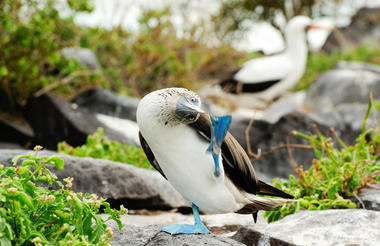

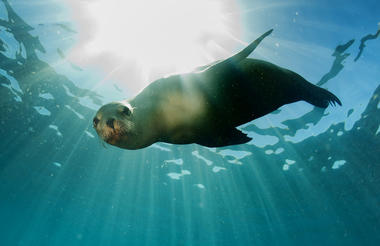
Breakfast
Lunch
Dinner
AM: ESPAÑOLA ISLAND, GARDNER BAY
You’ll start your day at Gardner Bay, located on the northeastern coast of Hood Island. Here, you can relax on the beautiful beach, swim, or kayak in the clear waters. You might spot sea lions lounging nearby, swim alongside sea turtles, and even catch a glimpse of small white-tip reef sharks.
This area is also great for birdwatching, where you’ll see three species of Darwin finches: a subspecies of large-billed cactus finch (Geospiza fuliginosa), small-beaked ground finch (Geospiza fuliginosa), and singing finch (Certhidea olivacea). Both resident and migratory birds call this region home.
PM: SUAREZ POINT
In the afternoon, you’ll explore Suarez Point, a prime location to spot blue-footed boobies, albatrosses, and Nazca boobies. This stunning oceanfront site offers dramatic views of large waved albatrosses launching from the cliffs.
Don’t miss the famous blowhole here, which shoots water 50 to 75 meters into the air — a spectacular sight and a perfect spot for photography.
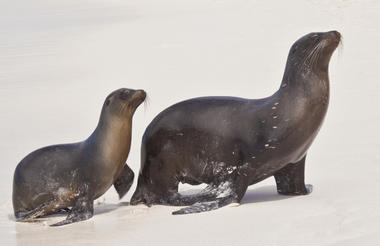
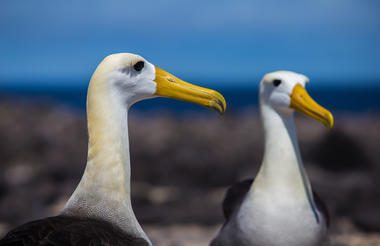
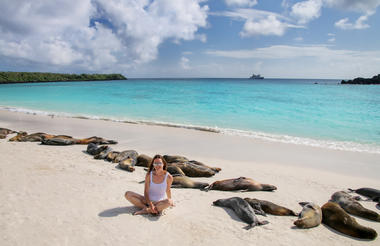
Breakfast
Lunch
Dinner
AM: CORMORANT POINT, CHAMPION ISLET
You’ll start your morning at Cormorant Point, home to what is likely the best flamingo lagoon in the Galapagos, nestled between two tuff lava cones. Here, you can observe a variety of shorebirds, including common stilts and white-cheeked pintail ducks, alongside graceful flamingos.
You’ll also explore two distinct beaches: "Green Beach," famous for its sparkling olivine crystal sand, and "Flour Sand Beach," known for its soft coral sand.
After your exploration, you’ll visit Champion Islet, a top snorkeling spot where you can swim alongside sea turtles, sea lions, and vibrant fish among the nearby coral reefs.
PM: POST OFFICE BAY
In the afternoon, you’ll head to Post Office Bay, where a wooden barrel placed by an 18th-century whaling ship served as a makeshift post office for mariners and travelers. You can try your hand at hand-delivering letters or postcards here — a charming tradition that continues today.
This site also marks the landing area for some of the first colonists in the islands. Spend the rest of your afternoon relaxing on the beach, soaking in the beauty and tranquility of the Galapagos.



Breakfast
Lunch
Dinner
AM: FAUSTO LLERENA BREEDING CENTRE
You’ll begin your visit at the Fausto Llerena Breeding Centre, located within the Galapagos National Park on Charles Darwin Avenue, about a 40-minute walk from Gus Angermeyer Tourist Pier.
Start at the Galapagos National Park Service information booth, then follow the trail to the Van Straelen Interpretation Centre before arriving at the breeding center. Along an elevated wooden path, you’ll have the chance to observe several species of Santa Cruz tortoises as well as tortoises from Española Island. Your visit will culminate at the baby-tortoise breeding corral, a truly special sight.
After your visit, you’ll transfer to Baltra airport for your flight back to the mainland.








